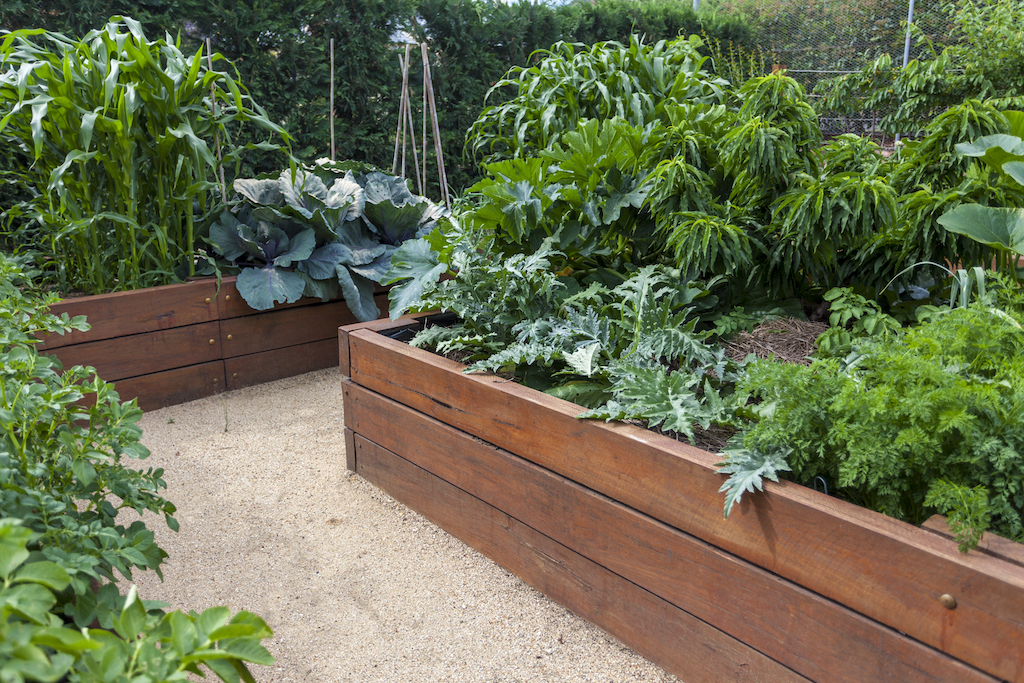Box gardening is ideal for areas where you cannot grow plants in in-ground soil. It is also trendy because planters are available in different colors, designs, shapes, sizes, and materials. Keep reading for more about gardening in boxes.
*This post contains compensated links. Find more info in my DISCLAIMER. As an Amazon Associate, I earn from qualifying purchases.
What Is Box Gardening?
Box gardening involves planting crops in planter boxes. This type of gardening allows you to plant crops in portable containers and is ideal for edible vegetables and herbs, flowers, and small shrubs. You do not need a backyard garden, as you can place the gardening box on your patio, deck, or balcony.

Gardening in boxes is pretty straightforward and fun. It involves the following steps:
Step 1: Fill The Container With Soil
You will need potting soil for any container that you intend to use. It is advisable not to use regular soil from your backyard. The soil may contain rocks or lots of clay, making it heavy. Disease spores and bugs also make your backyard soil less suitable for boxed gardening.
Step 2: Choose Your Plants
When choosing the crops to plant when gardening in a box, there are several factors to consider. Some essential factors include the size of your box, the space you are planning to put the containers in, and location.
Step 3: Care For Your Plant And Watch Your Box Garden Thrive
Once you have finished planting, ensure you take care of your plants. Water them slowly and deeply until water starts dripping out of the drainage holes, rather than small amounts of water frequently. Let the first inch of soil dry out completely before you water again.
Step Four: Harvest
Once your plants mature, you can harvest them and celebrate your hard work. You can grow plants that you will harvest all season long. You harvest plants like lettuce by cutting the entire plant an inch from the bottom of picking individual leaves and letting it regrow again.
Types Of Box Garden
There are different types of box gardens, which include:
- Wooden Planters
Wooden planters are the most common types of planters used in box gardening. They are available in different shapes and sizes. The main advantages of wooden planters are that they are cheap, have excellent drainage, and are easy to build. You can even decide to make your own.
However, these planters are heavy and prone to rotting.
- Plastic Planters
Plastic planters are also common. They are long-lasting, lightweight, durable, affordable, and available in different colors and shapes. However, they are not ideal for heavy plants.
- Ceramic Planters
Ceramic planters are available in various sizes, designs, and colors. They have better drainage and are attractive, making them ideal for both outdoor and indoor decor. However, they are less common because they are heavy, breakable, and costly.
- Terracotta Planters
Terracotta planters are affordable, have excellent drainage, and are very attractive. However, they are breakable and heavy.
- Metal Planters
Metal planters are cheap and look nice. Their key disadvantages are poor drainage and can overheat the crops.
Ways To Use Box Gardening
Some people use box gardening for decorative purposes, while others use them for edible plants only. However, you can find a perfect balance by planting edible plants and ornamental plants. Some blueberry bushes have attractive colors, while some herbs stay green all year long like rosemary.
If you want to use box gardening for decorative purposes only, you can grow different colored flowers. A window planter box or railing planters are ideal for flowers in ornamental box gardening. Identify flowers ideal for sunny, hot spots and those that thrive well in shades.
Flowers are also ideal for box gardening landscaping. But when it comes to landscaping, you can have a variety of boxes, such as raised planter boxes, railing planters, a decking planter, or a trellis planter. Landscaping allows you to be creative and play around with plants too. You can grow flowers, small shrubs, and edible plants.
Alternatively, you can use your box garden exclusively for vegetables, herbs, and fruits. A wide variety of these plants are ideal for box gardening. In addition, it is a perfect method of ensuring you get a constant supply of fresh produce in your kitchen.
Best Plants For Box Gardening
Leafy greens like lettuce, spinach, and kales, or herbs like cilantro, mint, and parsley are some of the best plants for box gardening. Squash, peppers, or tomatoes are also suitable though they need six to eight hours of daily sunlight. This means you will need a spot with adequate sunlight or have to regularly move the container for enough sunlight.
How much time you dedicate to caring for your plants will also determine the plants you will grow in your boxes. If you plant edible plants, you should devote some time to caring for them because they need to be watered once or twice every day during the summer. However, you can plant Mediterranean herbs such as basil, thyme, and rosemary, which thrive well with little care.
The size of your planter will also determine the plants that you will grow. If your planter is large, then you have more room to play around. You can combine your favorite herbs and veggies in your gardening box. But make sure they are correctly spaced out.
Alternatively, you can pick a single large plant that will take up the entire planter box, such as tomato plant or squash. These plants need much space in the soil for growth and good yield.
Best Locations For Box Gardening
Box gardening involves growing plants in boxes, making it easy to grow them anywhere. However, patios and decks are some of the most common places for boxed gardening. You can grow plants in different planters and place them on your balcony, patio, or deck.
Box gardening is also ideal for raised bed gardening, which you can do in the backyard. This type of gardening will combine the benefits of both boxes and raised bed gardening.
Another popular location for boxed gardening is on window sills. You can grow various flowers on a window planter box for aesthetic purposes. Planting your favorite veggies and herbs in your kitchen window allows for easy picking. Railing planters are ideal for growing plants on fences.
Planters are available in various designs, colors, sizes, shapes, and materials, making box gardening ideal for both indoor and outdoor gardening. Home gardeners have numerous designs and ideas for this type of gardening.
FAQs – Box Gardening
It important to have a depth of at least 12-18 inches for any garden box. This allows sufficient room for plant roots to grow and spread. It also allow for proper water drainage.
There’s a variety of natural materials you can line a garden box with. Leaves, cut grass, even cardboard are all good materials to use at the bottom of a garden box .
